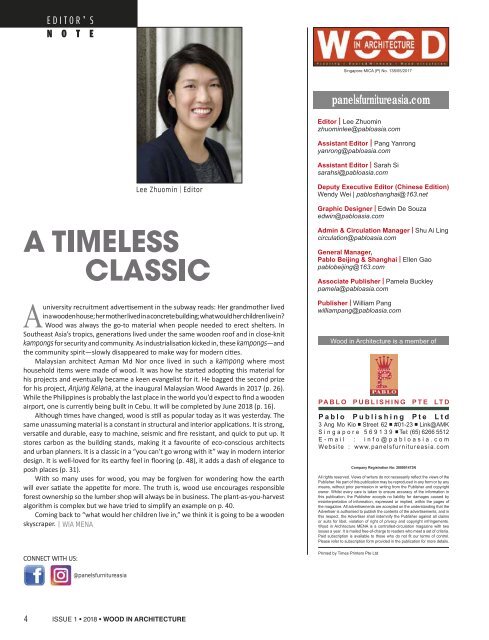Wood In Architecture Issue 1, 2018
First published in 2017, Wood in Architecture (WIA) is a bi-annual trade magazine devoted to the international timber construction sector. The newest addition to the Panels & Furniture Group of wood magazines, WIA features in-depth insights to the latest industry news, incredible projects and leading trade events. WIA is an advocate for timber as a material of choice for today’s built environment, and is the perfect source of inspiration for architects, builders, engineers and interior designers across the globe.
First published in 2017, Wood in Architecture (WIA) is a bi-annual trade magazine devoted to the international timber construction sector. The newest addition to the Panels & Furniture Group of wood magazines, WIA features in-depth insights to the latest industry news, incredible projects and leading trade events. WIA is an advocate for timber as a material of choice for today’s built environment, and is the perfect source of inspiration for architects, builders, engineers and interior designers across the globe.
Create successful ePaper yourself
Turn your PDF publications into a flip-book with our unique Google optimized e-Paper software.
Singapore MICA (P) No. 138/05/2017<br />
panelsfurnitureasia.com<br />
Editor | Lee Zhuomin<br />
zhuominlee@pabloasia.com<br />
Assistant Editor | Pang Yanrong<br />
yanrong@pabloasia.com<br />
Assistant Editor | Sarah Si<br />
sarahsi@pabloasia.com<br />
Lee Zhuomin | Editor<br />
Deputy Executive Editor (Chinese Edition)<br />
Wendy Wei | pabloshanghai@163.net<br />
Graphic Designer | Edwin De Souza<br />
edwin@pabloasia.com<br />
Admin & Circulation Manager | Shu Ai Ling<br />
circulation@pabloasia.com<br />
General Manager,<br />
Pablo Beijing & Shanghai | Ellen Gao<br />
pablobeijing@163.com<br />
Associate Publisher | Pamela Buckley<br />
pamela@pabloasia.com<br />
A<br />
university recruitment advertisement in the subway reads: Her grandmother lived<br />
in a wooden house; her mother lived in a concrete building; what would her children live in?<br />
<strong>Wood</strong> was always the go-to material when people needed to erect shelters. <strong>In</strong><br />
Southeast Asia’s tropics, generations lived under the same wooden roof and in close-knit<br />
kampongs for security and community. As industrialisation kicked in, these kampongs—and<br />
the community spirit—slowly disappeared to make way for modern cities.<br />
Malaysian architect Azman Md Nor once lived in such a kampong where most<br />
household items were made of wood. It was how he started adopting this material for<br />
his projects and eventually became a keen evangelist for it. He bagged the second prize<br />
for his project, Anjung Kelana, at the inaugural Malaysian <strong>Wood</strong> Awards in 2017 (p. 26).<br />
While the Philippines is probably the last place in the world you’d expect to find a wooden<br />
airport, one is currently being built in Cebu. It will be completed by June <strong>2018</strong> (p. 16).<br />
Although times have changed, wood is still as popular today as it was yesterday. The<br />
same unassuming material is a constant in structural and interior applications. It is strong,<br />
versatile and durable, easy to machine, seismic and fire resistant, and quick to put up. It<br />
stores carbon as the building stands, making it a favourite of eco-conscious architects<br />
and urban planners. It is a classic in a “you can’t go wrong with it” way in modern interior<br />
design. It is well-loved for its earthy feel in flooring (p. 48), it adds a dash of elegance to<br />
posh places (p. 31).<br />
With so many uses for wood, you may be forgiven for wondering how the earth<br />
will ever satiate the appetite for more. The truth is, wood use encourages responsible<br />
forest ownership so the lumber shop will always be in business. The plant-as-you-harvest<br />
algorithm is complex but we have tried to simplify an example on p. 40.<br />
Coming back to “what would her children live in,” we think it is going to be a wooden<br />
skyscraper. | WIA MENA<br />
CONNECT WITH US:<br />
Publisher | William Pang<br />
williampang@pabloasia.com<br />
<strong>Wood</strong> in <strong>Architecture</strong> is a member of<br />
PABLO PUBLISHING PTE LTD<br />
Pablo Publishing Pte Ltd<br />
3 Ang Mo Kio ■ Street 62 ■ #01-23 ■ Link@AMK<br />
Singapore 569139 ■ Tel: (65) 6266 5512<br />
E-mail : info@pabloasia.com<br />
Website : www.panelsfurnitureasia.com<br />
Company Registration No: 200001473N<br />
All rights reserved. Views of writers do not necessarily reflect the views of the<br />
Publisher. No part of this publication may be reproduced in any form or by any<br />
means, without prior permission in writing from the Publisher and copyright<br />
owner. Whilst every care is taken to ensure accuracy of the information in<br />
this publication, the Publisher accepts no liability for damages caused by<br />
misinterpretation of information, expressed or implied, within the pages of<br />
the magazine. All advertisements are accepted on the understanding that the<br />
Advertiser is authorised to publish the contents of the advertisements, and in<br />
this respect, the Advertiser shall indemnify the Publisher against all claims<br />
or suits for libel, violation of right of privacy and copyright infringements.<br />
<strong>Wood</strong> in <strong>Architecture</strong> MENA is a controlled-circulation magazine with two<br />
issues a year. It is mailed free-of-charge to readers who meet a set of criteria.<br />
Paid subscription is available to those who do not fit our terms of control.<br />
Please refer to subscription form provided in the publication for more details.<br />
Printed by Times Printers Pte Ltd<br />
@panelsfurnitureasia<br />
4 ISSUE 1 • <strong>2018</strong> • WOOD IN ARCHITECTURE


















